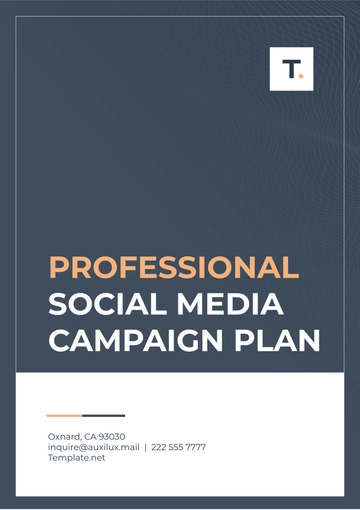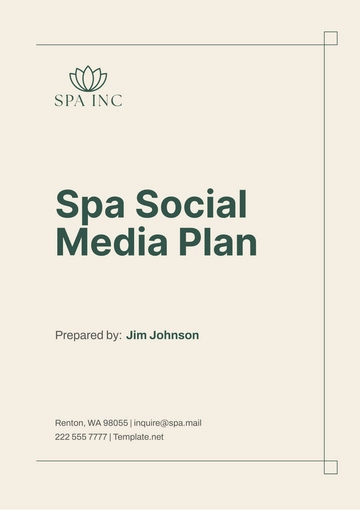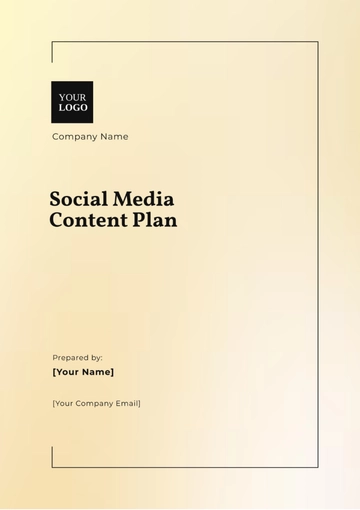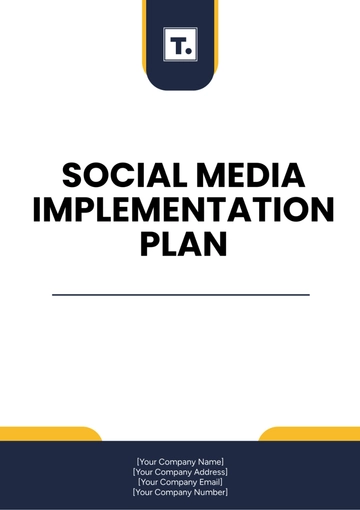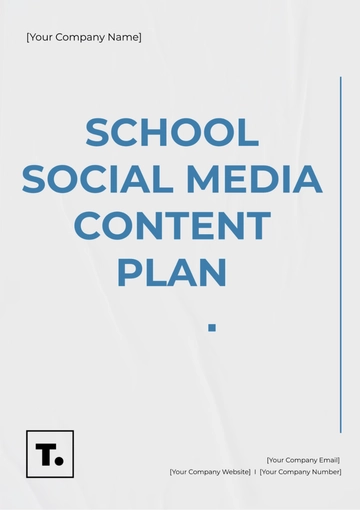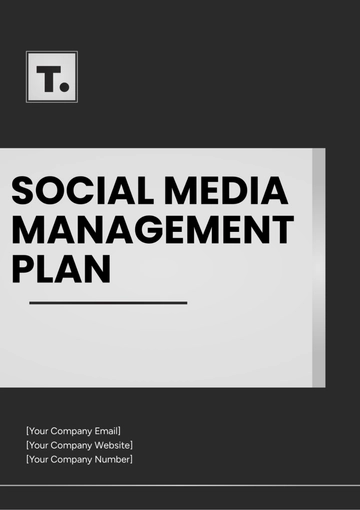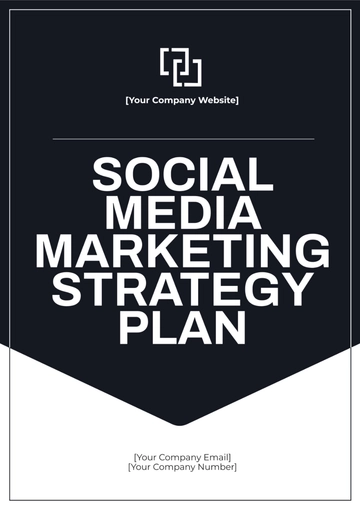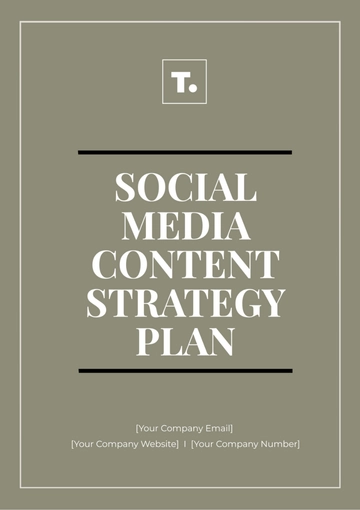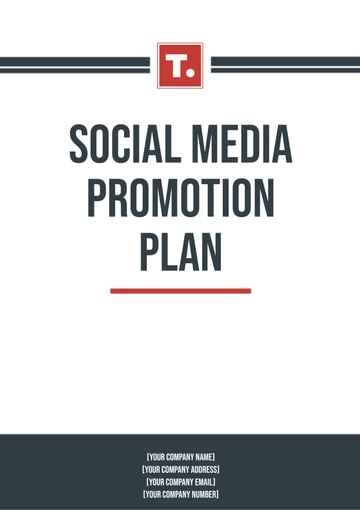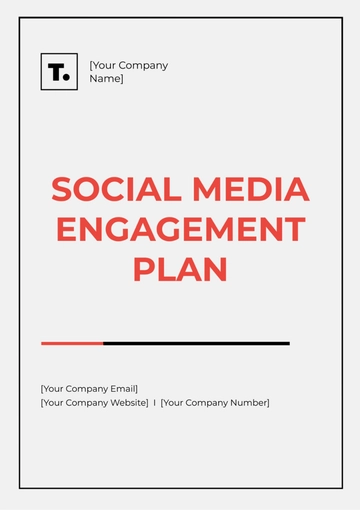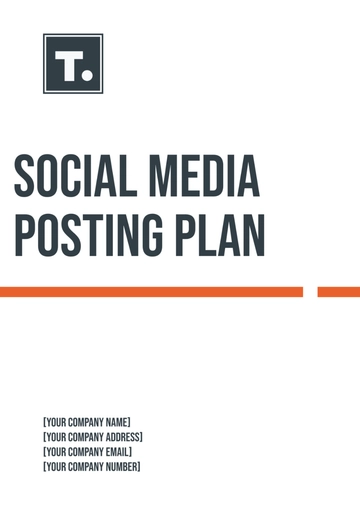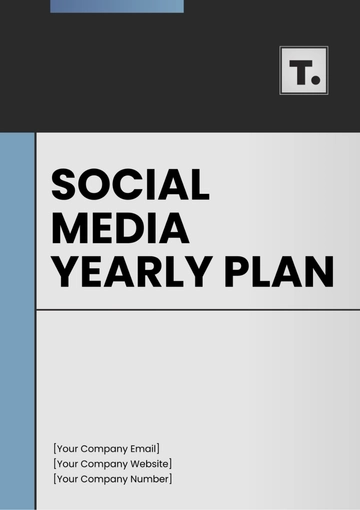Free Marketing Social Media Management Plan
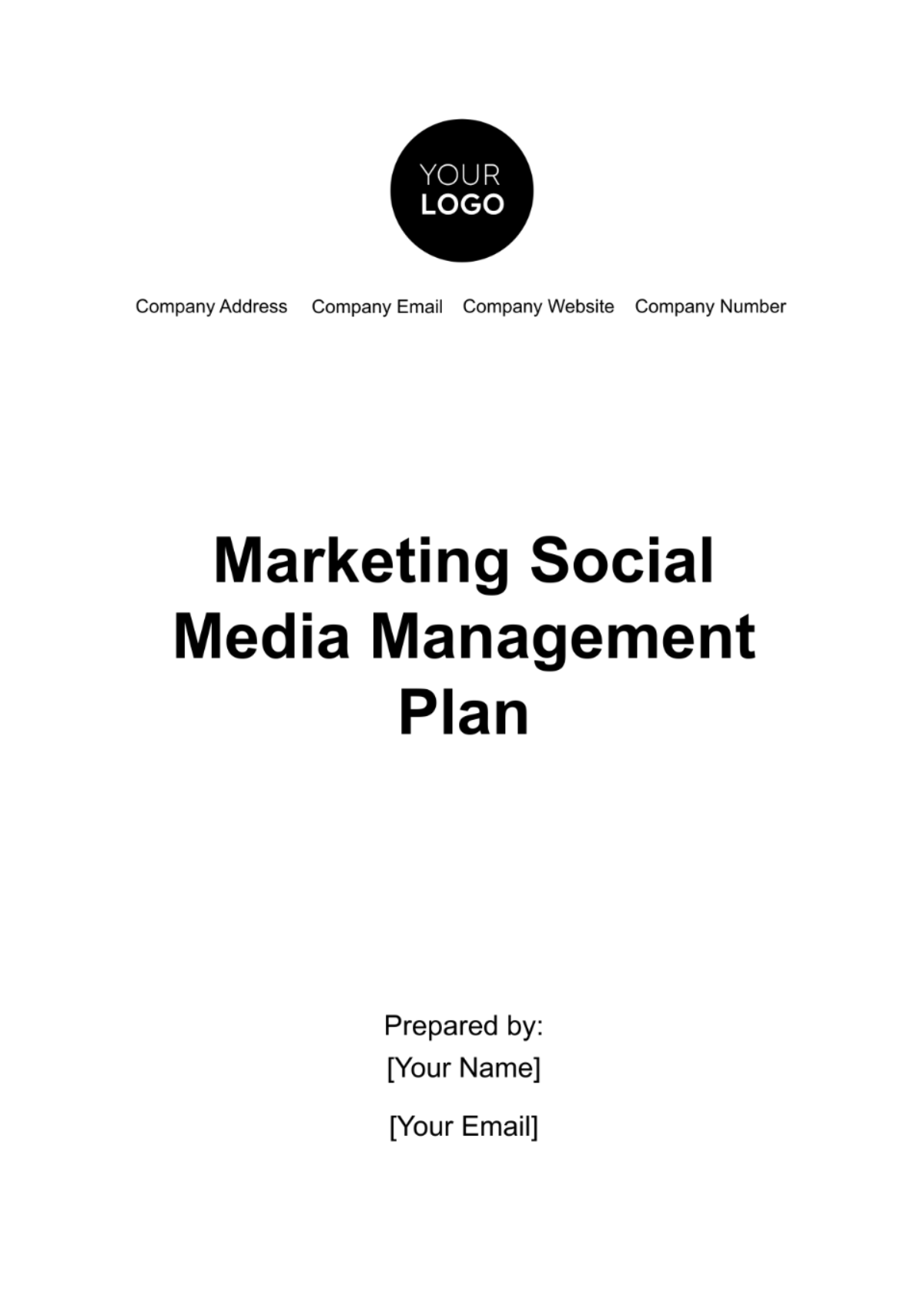
I. Company Overview
[Your Company Name] is a forward-thinking, environmentally conscious company dedicated to revolutionizing the world of consumer electronics. Established in 2050, [Your Company Name] has quickly become a recognized leader in the tech industry, setting new standards for eco-friendly innovation.
Our Mission
At [Your Company Name], our mission is clear: to empower individuals and businesses to make sustainable choices without compromising on technology. We are committed to creating cutting-edge consumer electronics that not only enhance everyday lives but also minimize their impact on the environment. Our guiding principles include:
Sustainability | We are deeply committed to reducing electronic waste, conserving energy, and using eco-friendly materials in our product design and manufacturing processes. |
Innovation | [Your Company Name] is synonymous with innovation. We constantly push the boundaries of technology to provide our customers with state-of-the-art gadgets that are both functional and environmentally responsible. |
Education | We believe that knowledge is the key to sustainable living. [Your Company Name] actively engages with our community to provide information, tips, and resources for eco-conscious living in the digital age. |
Our Product Range
[Your Company Name] offers a diverse range of eco-friendly consumer electronics, including:
Solar-Powered Gadgets | Harnessing the power of the sun, our solar-powered devices reduce the need for traditional energy sources, offering portable and sustainable solutions for modern living. |
Recycled Materials | We incorporate recycled materials into the design of our products wherever possible, reducing waste and minimizing the carbon footprint. |
Energy-Efficient Devices | Our energy-efficient devices are engineered to optimize power consumption, saving users money on energy bills while reducing environmental impact. |
Eco Accessories | In addition to our gadgets, we offer a selection of eco-friendly accessories that complement our product line, such as sustainable phone cases and charging solutions. |
II. Goals And Objectives
Objective 1: Increase Brand Awareness
Goal: To elevate [Your Company Name] brand recognition and visibility within the eco-conscious consumer electronics market.
Key Performance Indicators (KPIs):
Social Media Reach | Increase monthly reach on all platforms by 20%. |
Impressions | Achieve a 15% growth in monthly impressions. |
Brand Mentions | Monitor and respond to brand mentions, aiming for a 30% increase in positive mentions. |
Objective 2: Drive Website Traffic
Goal: To channel social media audiences to the [Your Company Name] website for product exploration and engagement.
Key Performance Indicators (KPIs):
Click-Through Rates (CTR) | Boost CTR on social media posts by 10% over the quarter. |
Website Visits | Increase the monthly website visit count by 25%. |
Conversion Rates | Improve conversion rates by 5% through targeted social media traffic. |
Objective 3: Boost Sales And Revenue
Goal: To directly contribute to revenue growth through social media marketing efforts.
Key Performance Indicators (KPIs):
Sales Generated | Increase the number of sales attributed to social media campaigns by 15% quarterly. |
Average Order Value (AOV) | Elevate the AOV by 8% by promoting high-value product bundles. |
Return On Ad Spend (ROAS) | Achieve a minimum ROAS of 5:1 for paid social media advertising. |
III. Target Audience
Understanding [Your Company Name] diverse target audience is essential for crafting personalized and engaging social media content. Our research and segmentation have identified the following customer personas:
A. Eco-Conscious Shoppers
Demographics | Primarily aged 25-45, both genders, middle to upper-middle-class. |
Interests | Environmentally friendly products, sustainability, eco-lifestyle. |
Behavior | Actively seek eco-friendly alternatives, willing to pay premium prices for sustainable tech. |
Challenges | Finding reliable information on eco-products and affordability concerns. |
Content Preferences | Educational content on green technology, product comparisons, reviews, and tips on reducing ecological footprints. |
B. Tech Enthusiasts
Demographics | Broad age range, leaning towards younger adults, predominantly male. |
Interests | Cutting-edge technology, gadgetry, and staying up-to-date with tech trends. |
Behavior | Early tech adopters, active on tech forums and blogs. |
Challenges | Finding eco-friendly tech that matches their performance expectations. |
Content Preferences | Detailed product specifications, tech reviews, comparisons, and announcements of the latest innovations. |
C. Eco-Savvy Parents
Demographics | Parents aged 30-50, both genders. |
Interests | Family-oriented eco-living, safety, and educational gadgets. |
Behavior | Seek tech solutions that align with their parenting values, and prioritize durability. |
Challenges | Balancing screen time for children, ensuring tech is child-friendly and educational. |
Content Preferences | Articles and videos on tech for kids, safety guidelines, and recommendations for family-friendly devices. |
D. Small Business Owners
Demographics | Entrepreneurs and small business owners, aged 30-60, both genders. |
Interests | Cost-effective and sustainable tech solutions for their businesses. |
Behavior | Seek tools that improve efficiency, save costs, and have a positive environmental impact. |
Challenges | Finding technology that scales for small businesses, budget constraints. |
Content Preferences | Case studies, success stories, and expert insights on using EcoGadgets for business growth. |
E. Eco-Activists And Advocates
Demographics | Diverse age groups and a strong commitment to environmental causes. |
Interests | Climate change, eco-activism, sustainable living. |
Behavior | Passionate about raising awareness, active in environmental organizations. |
Challenges | Access to credible information, amplifying their message effectively. |
Content Preferences | Shareable content on environmental issues, partnerships with eco-causes, and opportunities for advocacy. |
IV. Platform Selection
Selecting the right social media platforms is critical to reaching our target audience effectively and delivering content that resonates with them. Below, we provide an in-depth analysis of each platform's suitability for [Your Company Name]:
Target Audience | General consumers of all age groups who are interested in eco-friendly electronics. |
Content Focus | We will use Facebook to share a variety of content, including product updates, eco-friendly tips and guides, customer testimonials, and interactive polls and surveys. This platform allows for longer-form posts and discussions, making it ideal for engaging with our community. |
Rationale | Facebook's broad user base and diverse demographics make it an excellent choice for reaching a wide audience. Additionally, the platform's community-focused features, such as groups and events, will enable us to foster a sense of belonging and shared values among our followers. |
Target Audience | Primarily millennials and Gen Z consumers who are visually oriented and value eco-conscious living. |
Content Focus | Instagram will be our primary platform for visual storytelling. We will showcase our products in real-life settings, share behind-the-scenes content, and feature user-generated content. Instagram Stories and Reels will be used for short, engaging videos and highlights. |
Rationale | Instagram's visually-driven nature aligns perfectly with our eco-friendly and stylish product line. Its younger user base is more receptive to authentic, visually appealing content, making it a valuable platform for building brand loyalty. |
V. Content Strategy
The content strategy for [Your Company Name] is designed to captivate our target audience, foster engagement, and ultimately drive brand affinity and sales. By tailoring content to the unique characteristics of each social media platform, we aim to provide value, entertainment, and information that resonates with our audience. Our content strategy encompasses the following key components:
Content Types
Educational Content | Informative articles, blog posts, and videos that highlight the eco-friendly features of our products, provide sustainability tips, and educate our audience about environmental issues. |
Visual Content | High-quality images, infographics, and short videos showcasing our products, behind-the-scenes glimpses, and visually appealing environmental content. |
User-Generated Content (UGC) | Encouraging our customers to share their experiences with EcoGadgets products through photos, reviews, and testimonials. |
Interactive Content | Contests, polls, quizzes, and interactive stories to engage our audience and gather valuable feedback. |
Product Updates | Announcements of new product launches, features, and updates to keep our audience informed. |
VI. Paid Advertising
[Your Company Name] will allocate a portion of the marketing budget for paid social media advertising campaigns. The budget will be distributed among different platforms based on their relevance and historical performance.
Platform | Monthly Budget Allocation | Key Performance Indicators (KPIs) |
$4000 |
| |
$3000 |
|
VII. Monitoring And Analytics
Effective monitoring and analytics are vital for understanding how [Your Company Name] social media efforts are performing and for making informed decisions to optimize our strategy.
Tools And Platforms
To effectively monitor and analyze our social media presence, we will utilize a set of robust tools and platforms, including:
Google Analytics | For tracking website traffic, conversions, and referral sources driven by our social media efforts. |
Social Media Management Tools | We will leverage tools like Hootsuite, Buffer, or Sprout Social to schedule posts, manage engagement, and gather data on post-performance. |
Social Media Insights | Each platform provides its own analytics dashboard, which we will use to track platform-specific metrics like reach, engagement, follower growth, and demographics. |
Third-Party Analytics Software | Depending on campaign needs, we may employ third-party analytics software to gain deeper insights into our social media data. |
VIII. Conclusion
This management plan encompasses clear objectives, audience targeting, content strategies, and compliance measures to guide our social media marketing efforts effectively. By implementing this plan, we aim to not only enhance brand awareness, drive website traffic, boost sales, and elevate customer engagement but also to ensure that all our activities adhere to legal and regulatory requirements. Our commitment to ethical practices, transparency, and continuous improvement will be the driving force behind our success in the dynamic world of social media marketing.
- 100% Customizable, free editor
- Access 1 Million+ Templates, photo’s & graphics
- Download or share as a template
- Click and replace photos, graphics, text, backgrounds
- Resize, crop, AI write & more
- Access advanced editor
Our Marketing Social Media Management Plan Template is your ultimate solution for streamlined social media success. Crafted by experts, this comprehensive template provides a strategic framework to boost your brand's online presence. From content calendars to engagement strategies, it's your roadmap to social media supremacy. Elevate your marketing game today!
You may also like
- Finance Plan
- Construction Plan
- Sales Plan
- Development Plan
- Career Plan
- Budget Plan
- HR Plan
- Education Plan
- Transition Plan
- Work Plan
- Training Plan
- Communication Plan
- Operation Plan
- Health And Safety Plan
- Strategy Plan
- Professional Development Plan
- Advertising Plan
- Risk Management Plan
- Restaurant Plan
- School Plan
- Nursing Home Patient Care Plan
- Nursing Care Plan
- Plan Event
- Startup Plan
- Social Media Plan
- Staffing Plan
- Annual Plan
- Content Plan
- Payment Plan
- Implementation Plan
- Hotel Plan
- Workout Plan
- Accounting Plan
- Campaign Plan
- Essay Plan
- 30 60 90 Day Plan
- Research Plan
- Recruitment Plan
- 90 Day Plan
- Quarterly Plan
- Emergency Plan
- 5 Year Plan
- Gym Plan
- Personal Plan
- IT and Software Plan
- Treatment Plan
- Real Estate Plan
- Law Firm Plan
- Healthcare Plan
- Improvement Plan
- Media Plan
- 5 Year Business Plan
- Learning Plan
- Marketing Campaign Plan
- Travel Agency Plan
- Cleaning Services Plan
- Interior Design Plan
- Performance Plan
- PR Plan
- Birth Plan
- Life Plan
- SEO Plan
- Disaster Recovery Plan
- Continuity Plan
- Launch Plan
- Legal Plan
- Behavior Plan
- Performance Improvement Plan
- Salon Plan
- Security Plan
- Security Management Plan
- Employee Development Plan
- Quality Plan
- Service Improvement Plan
- Growth Plan
- Incident Response Plan
- Basketball Plan
- Emergency Action Plan
- Product Launch Plan
- Spa Plan
- Employee Training Plan
- Data Analysis Plan
- Employee Action Plan
- Territory Plan
- Audit Plan
- Classroom Plan
- Activity Plan
- Parenting Plan
- Care Plan
- Project Execution Plan
- Exercise Plan
- Internship Plan
- Software Development Plan
- Continuous Improvement Plan
- Leave Plan
- 90 Day Sales Plan
- Advertising Agency Plan
- Employee Transition Plan
- Smart Action Plan
- Workplace Safety Plan
- Behavior Change Plan
- Contingency Plan
- Continuity of Operations Plan
- Health Plan
- Quality Control Plan
- Self Plan
- Sports Development Plan
- Change Management Plan
- Ecommerce Plan
- Personal Financial Plan
- Process Improvement Plan
- 30-60-90 Day Sales Plan
- Crisis Management Plan
- Engagement Plan
- Execution Plan
- Pandemic Plan
- Quality Assurance Plan
- Service Continuity Plan
- Agile Project Plan
- Fundraising Plan
- Job Transition Plan
- Asset Maintenance Plan
- Maintenance Plan
- Software Test Plan
- Staff Training and Development Plan
- 3 Year Plan
- Brand Activation Plan
- Release Plan
- Resource Plan
- Risk Mitigation Plan
- Teacher Plan
- 30 60 90 Day Plan for New Manager
- Food Safety Plan
- Food Truck Plan
- Hiring Plan
- Quality Management Plan
- Wellness Plan
- Behavior Intervention Plan
- Bonus Plan
- Investment Plan
- Maternity Leave Plan
- Pandemic Response Plan
- Succession Planning
- Coaching Plan
- Configuration Management Plan
- Remote Work Plan
- Self Care Plan
- Teaching Plan
- 100-Day Plan
- HACCP Plan
- Student Plan
- Sustainability Plan
- 30 60 90 Day Plan for Interview
- Access Plan
- Site Specific Safety Plan




